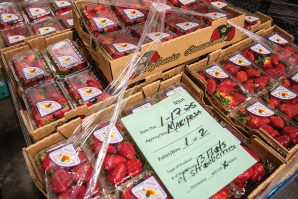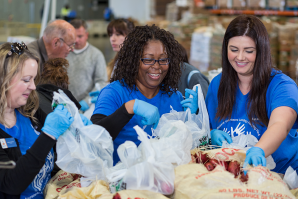It’s a waterlogged Thursday morning in mid-November, and a line of umbrellas leads up to the entrance of the open-air distribution center at River City Food Bank in Midtown. Across the street is the Sacramento Natural Foods Co-op (a major supporter of the food bank), where $5 might get you an organic head of cabbage.
There’s no shortage of patrons at either location, though today, the one with free produce might be better staffed. Volunteers huddle shoulder to shoulder, handing out staples like potatoes, rice and lentils to those pushing carts through the line, relieved to be out of the rain. Inside the warehouse, other volunteers receive shipments, organize and prep food for distribution. It’s a bustling operation that appears well under control. You wouldn’t know they’re in the eye of the storm.
“This is definitely the worst food insecurity crisis I’ve seen,” says Amanda McCarthy, executive director at River City, who’s worked at food banks on and off for more than 25 years. She cites an amalgamation of factors that have been snowballing since COVID-19 — job losses, unaffordable housing, resettling refugees, rising grocery prices and, most recently, the federal government shutdown and temporary suspension of SNAP food benefits (known as CalFresh in California), which affected 270,000 recipients in Sacramento County and 5.5 million statewide.
As the shutdown commenced on Oct. 1, state and county government entities, food banks and their community partners followed the political volley over food stamps and disseminated information to CalFresh recipients. In the first week of November, a critical point was reached at which benefits had not been deposited for that pay period. Recipients were in limbo for seven days as a legal battle played out in the federal courts over whether the Trump administration would cover food stamps during the shutdown.
Volunteers distribute carrots and other products at River City
Food Bank. (Photo courtesy of River City Food Bank)

“Things were changing every day,” says Amy Dierlam, a CalFresh outreach director who works at River City Food Bank’s Midtown location. “What we found was people had a lot of questions and a lot of anxiety. They really rely on this money. … Some people were panicking.”
For many CalFresh recipients, feeding one’s family means juggling food stamps, food bank handouts and personal funds. In California, the monthly individual benefit can be as little as $24. Recipients may need to visit multiple food banks throughout the week, requiring transportation and the free time to stand in line.
And those lines stretched in the last week of October and first week of November as food banks launched into crisis mode. “Long, long lines,” Dierlam says, though River City did not run out of food at either of its dual locations in Midtown and Arden Arcade. “We did not run out of food because the community stepped up in a big way,” McCarthy says. More people volunteered. Supporters like the Co-op rallied to collect donations, keeping food on the shelves.
Related: There’s Free Food Every Weeknight at This Davis Park
It was the same story in Folsom.
“In crisis times like this, it’s easy to see the worst in people, but … we’ve also seen the best of humanity stepping up,” says Lisa Tuter, executive director at Twin Lakes Food Bank. “Quite honestly, our community did a lot better than our government did in the past couple months.”
On Nov. 7, suspended CalFresh benefits were paid in full due to a court ruling, and the government shutdown ended on Nov. 12. Still, almost a week after the resolution, the struggle continues for many. Because payments were late, “people may have had to defer bills or take other actions to help get through a really difficult period of time,” McCarthy says.
Ripples of frustration and uncertainty can be felt in the River City Food Bank line in Midtown.
Fresh produce is available at River City Food Bank. (Photo
courtesy of River City Food Bank)

One woman waiting in line demands to know why I hadn’t been out there a week ago, when food stamps were still frozen. While the news media may attempt to convey the dread of food insecurity and private desperation of hunger, these things stretch by the minutes. In this crisis, circumstances changed by the day and even by the hour. Unlike a wildfire or an economic recession, this was an artificially inflicted crisis, alleviated by mandate.
So the anxiety lingers. “The SNAP recipients being used as a pawn for the government shutdown is a cautionary tale of how assistance could be impacted in the future,” says Tuter.
However, she adds, rising prices are perhaps the single greatest detriment to food security, which has been attributed to pandemic-era inflation, labor shortages, environmental changes and tariffs, among other factors.
Related: Recycling Unused Food: On the Frontlines With the Agencies and Food Banks Making SB 1383 Work to Feed the Hungry
Billy Baker, a longtime River City Food Bank volunteer who relies on CalFresh because he has a disability, echoes what many are saying: Getting by is only getting harder. Everything is more expensive. “Our numbers are exceedingly growing. We’ve seen a lot of new individuals come in; they’re afraid, they don’t know what’s going on,” he says.
In Folsom, Twin Lakes has seen an influx of elderly people needing assistance. “So many stories I’ve heard, especially this year, from seniors who’ve worked their entire lives and never thought they’d be in a situation where they needed help; and all of a sudden, really can’t afford to meet basic needs,” says Tuter.
That need will grow during the holidays as food banks face their busiest time of year. “We were already serving 30,000 a month, and in the last few weeks we’ve seen an 18 percent increase,” says McCarthy. “We’re planning at least through the end of the year for a 15 to 20 percent increase in need.”
But food banks are also worried about the new year, when donations and volunteers are expected to drop off with news coverage in the post-giving season.
“Holidays shine a light on the need in our community and our neighbors experiencing food insecurity, but really it’s a year-round concern,” says McCarthy, who emphasizes that River City and many other food banks do not have requirements to receive food. “We want to make sure our community knows that we’re here.”
Reflecting the region’s diversity, Sacramento County’s 111 food distribution sites serve vastly different demographics. River City’s Arden location, for example, caters to the area’s Afghan refugee population, offering cuisine staples and, occasionally, halal meat such as lamb.
Due to these varied and ever-evolving needs, McCarthy says, flexible funding from donations is critical.
Consistency is key, Tuter adds. “Even if you donate $25 every month, everybody doing a little bit on a consistent basis is going to ensure that people coming through get their food,” she says. “If we have excess, we stash it away for a rainy day, because there will be a rainy day. In the eight years I’ve been in this role, there’ve been some rainy days.”
To find a food bank near you in Sacramento County, visit https://www.sacramentofoodbank.org/find-food.
–
Stay up to date on business in the Capital Region: Subscribe to the Comstock’s newsletter.
Recommended For You

There’s Free Food Every Weeknight at This Davis Park
How the Davis Night Market offers mutual aid on a ‘shoestring of a shoestring’ budget
You’ll find them standing in a corner of Davis’ Central Park every weeknight after dark, barely lit by a nearby streetlight, surrounded by cardboard boxes and plastic bags. This is the Davis Night Market, a grassroots organization that has been operating under the radar for over half a decade.

Recycling Unused Food: On the Frontlines With the Agencies and Food Banks Making SB 1383 Work to Feed the Hungry
The food recovery process for SB 1383 is divided into separate tiers. Tier 1, which involves large grocery chains and food distribution centers, went into effect in 2022. The following year, Rancho Cordova’s locker alone recovered 800,000 pounds of food. In that same period, Sacramento Food Bank & Family Services oversaw the redistribution of 14.6 million pounds of edible food that came directly from Capital Area grocery stores.

Out of the Landfill and Into the Compost Pile
Capital Region residents rise to the occasion of new organics recycling law
Separating food waste from trash used to be the stuff of hippies. But, unlike cork sandals, it’s not a matter of taste — it’s state law.

Opinion: Donating Funds is Critical, Donating Time is Priceless
While dollar donations are mission critical and help to keep the
figurative lights on at many nonprofits, hands-on volunteers are
also valuable — and the most in-demand type of volunteer role
needed is board service.



